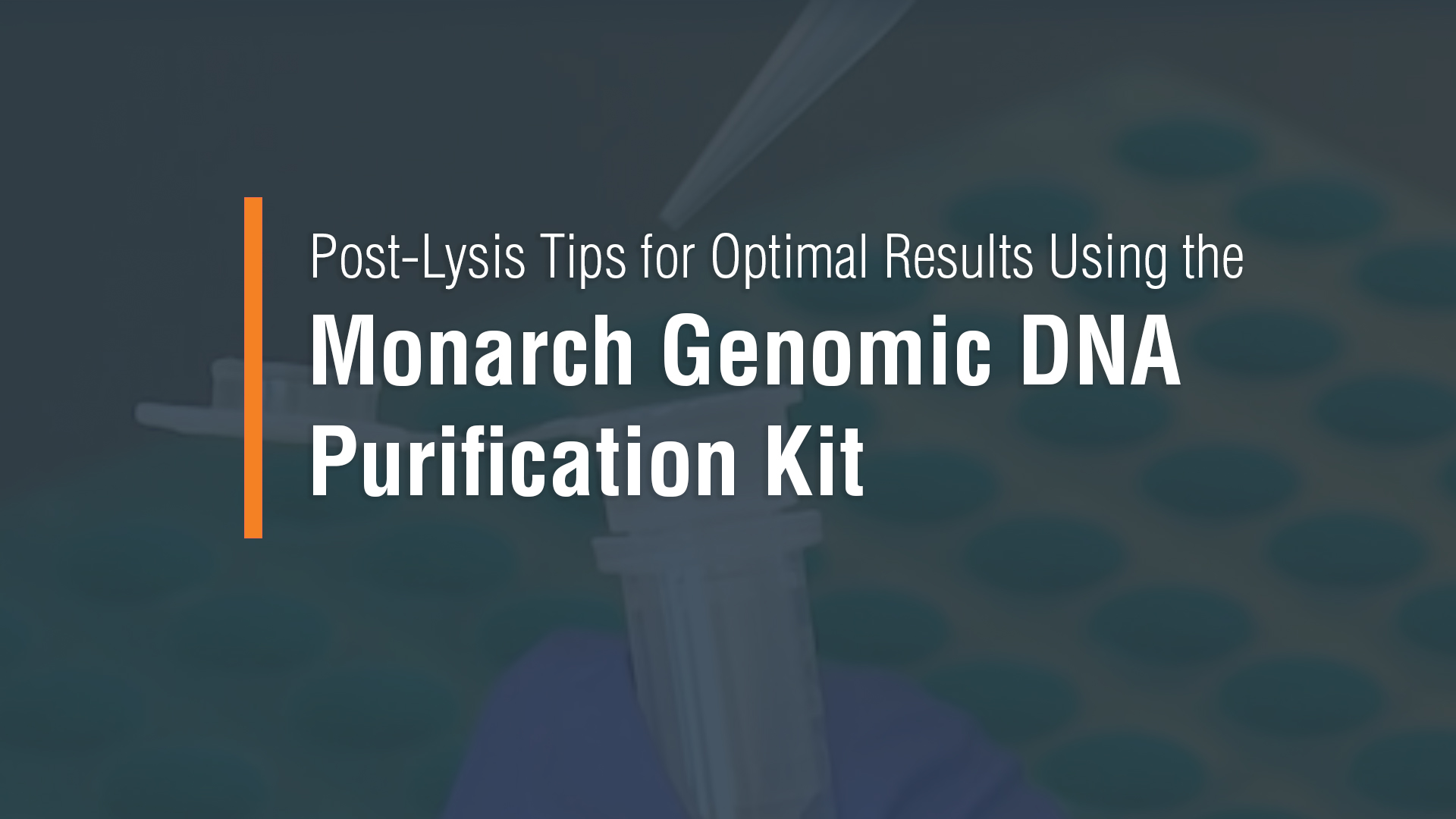Genomic DNA Extraction from Buccal Swabs (NEB #T3010)
Before You Begin:
- Store RNase A and Proteinase K at -20°C.
- Add ethanol (≥ 95%) to the Monarch gDNA Wash Buffer concentrate as indicated on the bottle label.
- Cold PBS (not supplied) is required.
- If available, a microcentrifuge pre-chilled to 4°C is recommended.
- Set a thermal mixer (e.g. ThermoMixer or similar device), or a heating block to 56°C for sample lysis.
- To prepare for elution, set a heating block to 60°C. Preheat the appropriate volume of elution buffer to 60°C (35–100 μl per sample). Confirm the temperature, as temperatures are often lower than indicated on the device.
- Do not load a single column with the lysed sample more than once; over-exposure of the matrix to the lysed sample can cause the membrane to expand and dislodge.
Protocol
- Add 1 ml cold PBS to 1.5 ml reaction tube.
- Scrape inside of cheek with commercial collection device (according to manufacturer’s recommendations).
- Cut off / break off buccal swab cell collection piece and place in the tube with the PBS.
- Vortex for 10 seconds to release cell material, then remove swab from the PBS.
- Pellet cellular material by centrifugation for 30 seconds (2000 x g) at 4°C if possible.
- With a pipette, remove most of the PBS, leaving ~100 μl of PBS behind with the cell pellet.
- Resuspend the pellet by vortexing.
- Add 10 μl Proteinase K and 3 μl RNase A, and vortex briefly.
- Add 100 μl Cell Lysis Buffer, vortex briefly, then incubate at 56°C for a minimum of 30 minutes in a thermal mixer with agitation at full speed (~1400 rpm).
- Proceed to Genomic DNA Binding and Elution.
GENOMIC DNA BINDING AND ELUTION
- Add 400 μl gDNA Binding Buffer to the sample and mix thoroughly by pulse-vortexing for 5-10 seconds. Thorough mixing is essential for optimal results.
- Transfer the lysate/binding buffer mix (~600 μl) to a gDNA Purification Column pre-inserted into a collection tube, without touching the upper column area. Proceed immediately to step 3. Do not reload the same column with more sample; over-exposure of the matrix to the lysed sample can cause the membrane to expand and dislodge. Avoid touching the upper column area with lysate/binding mix and avoid transferring foam that may have formed during lysis. Any material that touches the upper area of the column, including any foam, may lead to salt contamination in the eluate.
- Close the cap and centrifuge: first for 3 minutes at 1,000 x g to bind gDNA (no need to empty the collection tubes or remove from centrifuge) and then for 1 minute at maximum speed (> 12,000 x g) to clear the membrane. Discard the flow-through and the collection tube. For optimal results, ensure that the spin column is placed in the centrifuge in the same orientation at each spin step (for example, always with the hinge pointing to the outside of the centrifuge); ensuring the liquid follows the same path through the membrane for binding and elution can slightly improve yield and consistency.
- Transfer column to a new collection tube and add 500 μl gDNA Wash Buffer. Close the cap and invert a few times, so that the wash buffer reaches the cap. Centrifuge immediately for 1 minute at maximum speed (12,000 x g), and discard the flow through. The collection tube can be tapped on a paper towel to remove any residual buffer before reusing it in the next step. Inverting the spin column containing wash buffer prevents salt contamination in the eluate.
- Reinsert the column into the collection tube. Add 500 μl gDNA Wash Buffer and close the cap. Centrifuge immediately for 1 minute at maximum speed (>12,000 x g), then discard the collection tube and flow through.
- Place the gDNA Purification Column in a DNase-free 1.5 ml microfuge tube (not included). Add 35-100 μl preheated (60°C) gDNA Elution Buffer, close the cap and incubate at room temperature for 1 minute. Elution in 100 μl is recommended, but smaller volumes can be used and will result in more concentrated DNA but a reduced yield (20–25% reduction when using 35 μl). Eluting with preheated elution buffer will increase yields by ~20–40% and eliminates the need for a second elution. For applications in which a high DNA concentration is required, using a small elution volume and then eluting again with the eluate may increase yield (~10%). The elution buffer (10 mM Tris-Cl, pH 9.0, 0.1 mM EDTA) offers strong protection against enzymatic degradation and is optimal for long term storage of DNA. However, other low-salt buffers or nuclease-free water can be used if preferred. For more details on optimizing elution, please refer to “Considerations for Elution & Storage” in the product manual.
- Centrifuge for 1 minute at maximum speed (> 12,000 x g) to elute the gDNA.
Additional Resources you may find helpful:
- Monarch Spin gDNA Extraction Kit Product Manual
- Choosing Input Amounts for the Monarch Spin gDNA Extraction Kit
- Troubleshooting Guide for Genomic DNA Extraction & Purification
- Factors Affecting DNA Quality when Purifying gDNA from Blood and Tissues with the Monarch Spin gDNA Extraction Kit
- Guidelines for Handling Tissue Samples when using the Monarch Spin gDNA Extraction Kit

